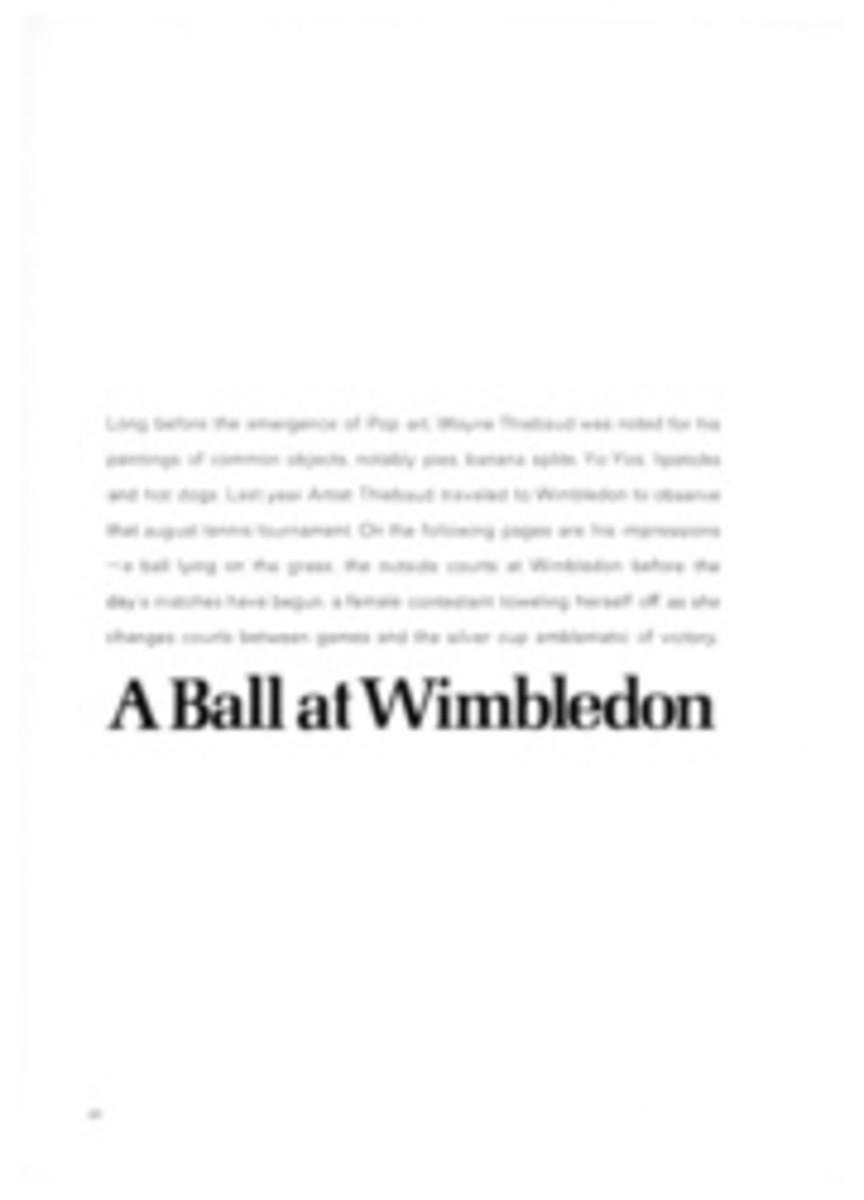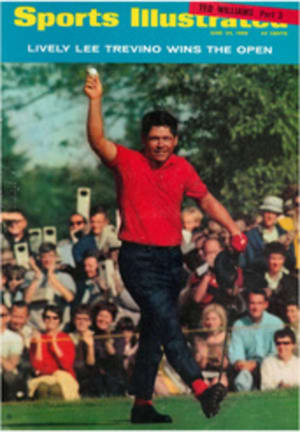
A Ball at Wimbledon
Long before the emergence of Pop art, Wayne Thiebaud was noted for his paintings of common objects, notably pies, banana splits, Yo-Yos, lipsticks and hot dogs. Last year Artist Thiebaud traveled to Wimbledon to observe that august tennis tournament. On the following pages are his impressions—a ball lying on the grass, the outside courts at Wimbledon before the day's matches have begun, a female contestant toweling herself off as she changes courts between games and the silver cup emblematic of victory.
For Tigers and Rabbits, Rules Are Rules
What can one tell a stranger going to Wimbledon for the first time? Even now after 40 years of rounding the tree-lined bend atop the hill and seeing that green, triangular oasis cupped in the gently sloping valley, I am excited by the view. Monster red London buses shuttle between the club and railway stations, crawling incongruously through the prosperous residential approaches, bringing a mishmash of spectators, officials and others to do with the tournament. Ticket touts pester all but the most purposeful from the bus stop to the entrance gate. If you have a colored ticket or a badge, you may pass through that gate, but never before midday. Wilhelm Bungert, wanting a practice session before his finals match against John Newcombe last year, was unable to break this rule. Jaroslav Drobny and I, among others, have in the past been embarrassingly refused permission without our badges, even though our faces were familiar to the guards. At Wimbledon rules are rules for tigers and rabbits alike.
Once within the iron gates, the broad walk lies before you. It is always good to amble along the walk, meeting and greeting friends, some unseen for 20 years. Progress is slow because the walk is jammed with people, among them program sellers and ice-cream vendors—oftentimes junior players who were unsuccessful in gaining a spot in the tournament. You will also see schoolgirls scrambling for pictures of the players, matrons filling bags with far too many candies from the help-yourself counters, tennis experts studying the scoreboard and players conferring seriously with tournament promoters from all over the world. At the east end of the walk are the tea lawns, where you can eat the strawberries and cream for which Wimbledon is famous. Nearby is the exclusive members' entrance, and around it loiter celebrity spotters. Perhaps they will see a movie star or maybe Princess Marina, the club president, who succeeded the late Queen Mary. Wimbledon has enjoyed regular royal patronage ever since the late King George V, then Prince of Wales, paid his first visit to the championships in 1907 and later donated the cup (left) received annually by the winner of the men's singles.
The 13 grass courts that support the famous center court and its 7,000-seat sister, court one, can be reached by asphalt paths that crisscross between them. It was on these courts—as a fan, then a competitor and finally as a writer—that I first caught glimpses of such players as Fred Perry, Don Budge, Ken Rosewall, Chuck McKinley and Billie Jean King (next page). Take a careful look at the players battling there now. Perhaps someone will one day be as well known.
Promotion from the outer courts to the enclosed court one and then into the historic center court itself is only for a favored few. Hemmed in by an oval of 15,000 intent faces, one experiences an eerie mixture of loneliness and oppression. Amplified clonks accompany each stroke, and cameras click with each diving volley. Many players wilt beneath the pressure, but few fail to embrace a subsequent inspiration that lifts them to new heights. Indeed, some wish never again to play on any other court.
When the day is done, it is good to enjoy a slowly sipped gin and tonic at the clubhouse. Chats with lifelong friends at the vast middle-Saturday cocktail party become the focus of one's fortnight. Martial music from the Guards's band in the corner merges with Field Marshal Montgomery's predictions of who is likely to win. Jean Borotra expounds on the authorized player—is he really going to be 70? Was it truly 1924 when he won the singles? It does not seem that long ago.
This year begins the Open era and Wimbledon moves on. Its standards are supreme, and as long as they continue so it will make little difference how the world designates those who compete—amateur, professional, authorized player or player—for it is the secret of the place that it demands and pulls the best out of everyone.
FOUR ILLUSTRATIONS
WAYNE THIEBAUD

